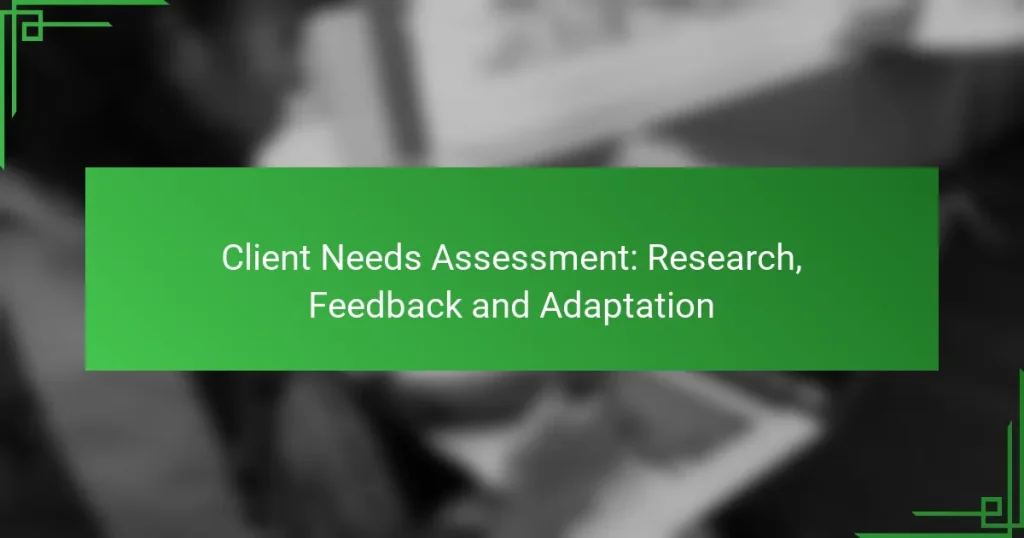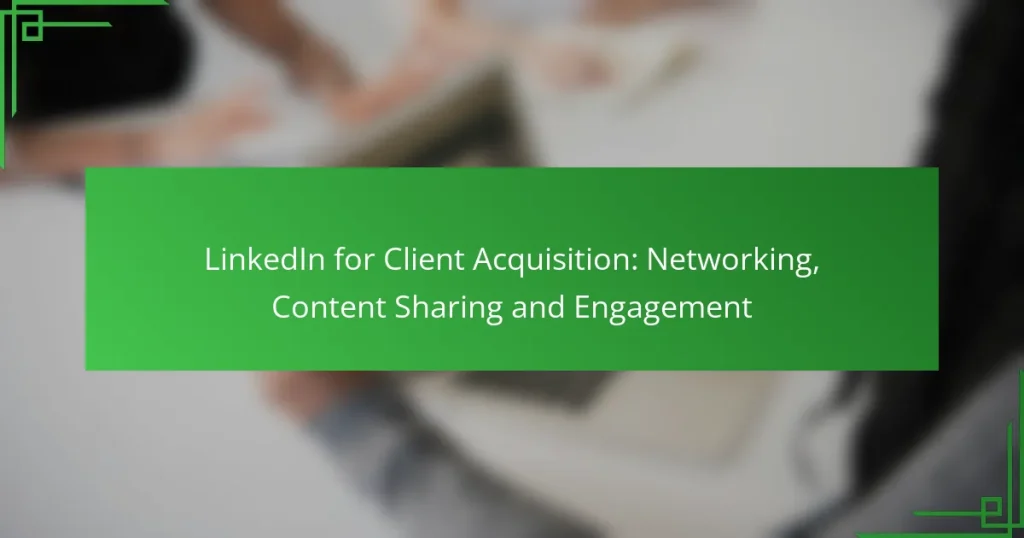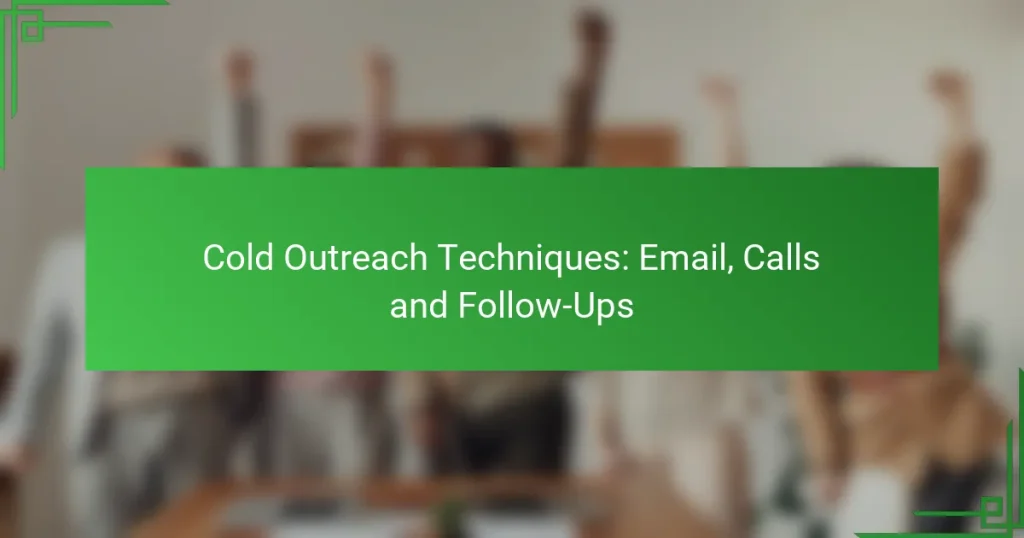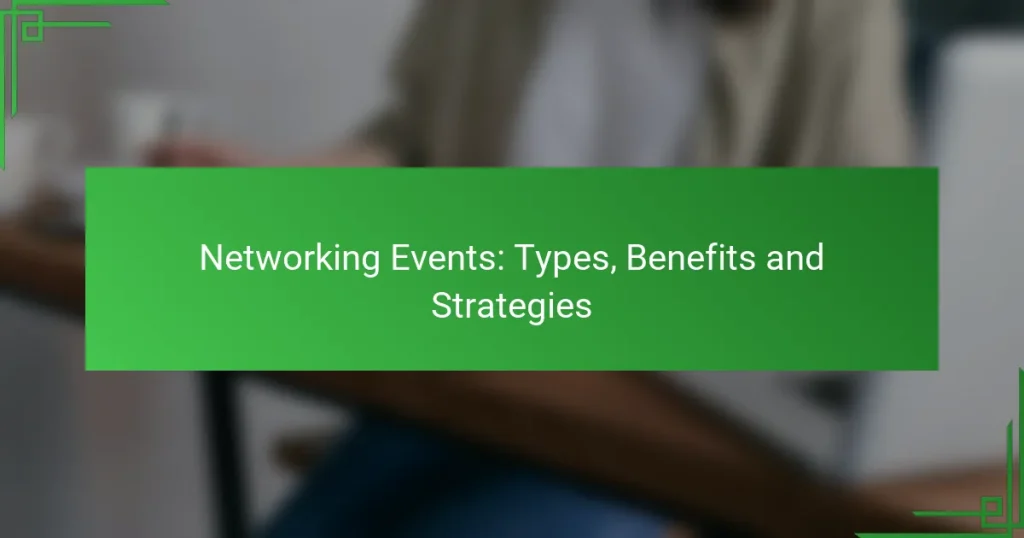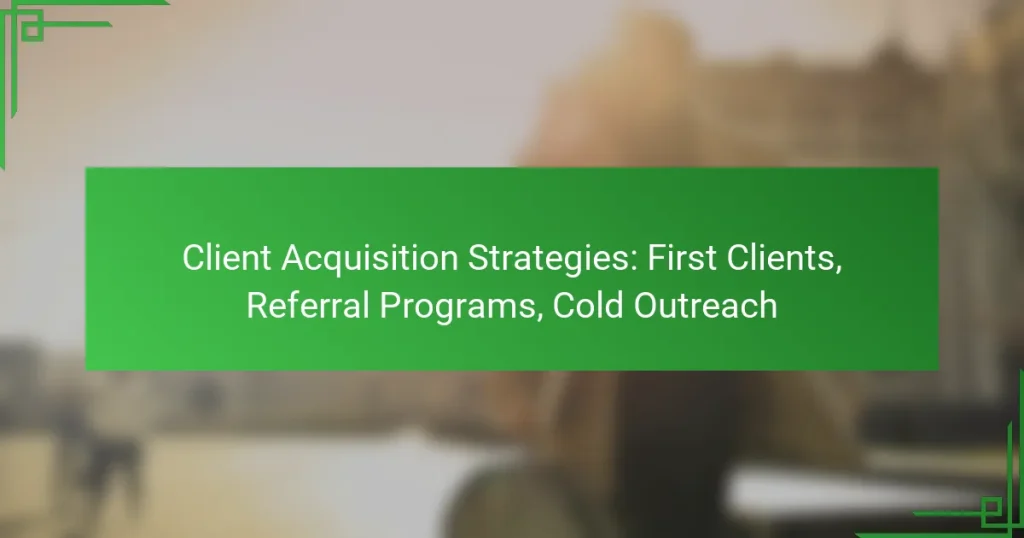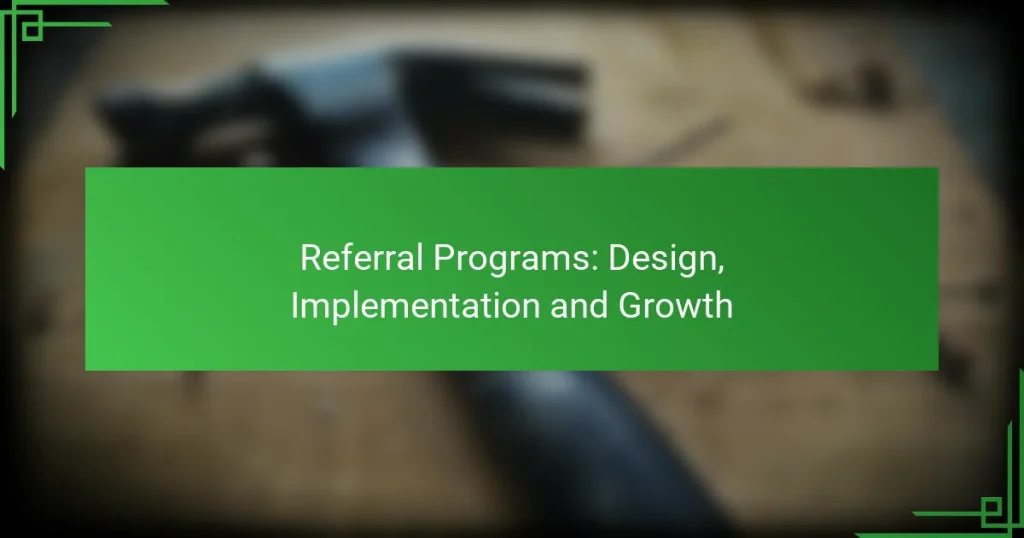In the competitive landscape of digital agencies, mastering client acquisition techniques is essential for sustainable growth. By focusing on relationship-building, showcasing expertise, and optimizing branding, agencies can effectively attract and retain clients. Implementing strategies such as SEO can further enhance visibility and drive organic traffic, ultimately converting leads into loyal customers.
Client Needs Assessment: Research, Feedback and Adaptation
LinkedIn for Client Acquisition: Networking, Content Sharing and Engagement
Cold Outreach Techniques: Email, Calls and Follow-Ups
Networking Events: Types, Benefits and Strategies
Client Acquisition Strategies: First Clients, Referral Programs, Cold Outreach
Referral Programs: Design, Implementation and Growth
What Are Effective Client Acquisition Techniques for Digital Agencies?
Effective client acquisition techniques for digital agencies include strategies that attract and retain clients through various channels. These methods focus on building relationships, showcasing expertise, and leveraging networks to generate leads and convert them into loyal customers.
Content Marketing Strategies
Content marketing is a powerful tool for digital agencies to demonstrate expertise and attract potential clients. By creating valuable content such as blog posts, case studies, and whitepapers, agencies can establish authority in their niche and drive organic traffic to their websites.
Agencies should focus on producing high-quality, relevant content that addresses the pain points of their target audience. Utilizing SEO best practices will enhance visibility and engagement, leading to higher conversion rates.
Social Media Engagement
Social media platforms are essential for digital agencies to connect with potential clients and showcase their work. Engaging with followers through regular posts, comments, and direct messages helps build relationships and trust.
Agencies should identify the platforms most frequented by their target audience and tailor their content accordingly. Consistent interaction and sharing of valuable insights can significantly boost brand awareness and client acquisition.
Networking Events Participation
Participating in networking events allows digital agencies to meet potential clients and industry peers face-to-face. These events can range from local meetups to larger conferences, providing opportunities to establish connections and promote services.
Agencies should prepare an elevator pitch and bring marketing materials, such as business cards and brochures, to effectively communicate their offerings. Following up with new contacts after the event is crucial for nurturing these relationships.
Email Marketing Campaigns
Email marketing remains an effective method for client acquisition, allowing agencies to reach potential clients directly. Crafting targeted email campaigns with personalized content can significantly increase engagement and conversion rates.
Agencies should segment their email lists based on client interests and behaviors to deliver relevant information. Regular newsletters, promotional offers, and informative content can keep potential clients engaged and informed about the agency’s services.
Referral Programs
Referral programs incentivize existing clients to recommend a digital agency to their network, creating a cost-effective way to acquire new clients. Offering rewards, such as discounts or free services, encourages satisfied clients to spread the word.
Agencies should clearly communicate the benefits of the referral program and make it easy for clients to participate. Tracking referrals and acknowledging clients who refer new business can further enhance loyalty and engagement.
How to Leverage SEO for Client Acquisition?
Leveraging SEO for client acquisition involves optimizing your website to improve visibility in search engine results, attracting potential clients organically. Effective SEO strategies can lead to increased traffic, higher conversion rates, and ultimately, more clients for your digital agency.
Keyword Research for Target Audience
Keyword research is essential for identifying the terms and phrases your target audience uses when searching for services like yours. Utilize tools such as Google Keyword Planner or SEMrush to discover relevant keywords with good search volume and manageable competition.
Focus on long-tail keywords that are specific to your services, as they often have lower competition and higher conversion potential. For example, instead of targeting “digital marketing,” consider “affordable digital marketing for small businesses in [Your City].”
On-Page Optimization Techniques
On-page optimization involves enhancing individual web pages to rank higher and earn more relevant traffic. Key techniques include optimizing title tags, meta descriptions, headers, and content with your targeted keywords.
Ensure that your content is valuable and answers the questions your audience is asking. Use internal linking to guide visitors to related content on your site, which can improve user experience and reduce bounce rates.
Local SEO Strategies
Local SEO is crucial for digital agencies targeting clients in specific geographic areas. Start by creating and optimizing your Google My Business listing, ensuring your business name, address, and phone number (NAP) are consistent across all platforms.
Encourage satisfied clients to leave positive reviews on Google and other review sites, as this can significantly enhance your local search visibility. Additionally, consider using local keywords in your content, such as “digital agency in [Your City]” to attract nearby clients effectively.
What Role Does Branding Play in Client Acquisition?
Branding is crucial in client acquisition as it creates a recognizable identity that attracts potential clients. A strong brand helps differentiate your agency from competitors and builds an emotional connection with your target audience.
Establishing a Unique Value Proposition
A unique value proposition (UVP) clearly articulates what sets your agency apart from others. It should address the specific needs of your target market and highlight the benefits they will receive by choosing your services. For example, if your agency specializes in eco-friendly marketing solutions, your UVP could emphasize sustainability and social responsibility.
To create an effective UVP, consider conducting market research to understand client pain points and preferences. Use this information to craft a statement that resonates with your audience and communicates your agency’s strengths.
Consistent Brand Messaging
Consistent brand messaging ensures that your agency communicates the same values and benefits across all platforms. This includes your website, social media, and marketing materials. Consistency builds recognition and trust, making it easier for potential clients to remember and choose your agency.
To maintain consistency, develop brand guidelines that outline your tone, style, and visual elements. Regularly review your content to ensure it aligns with these guidelines and reflects your agency’s mission and values.
Building Trust Through Case Studies
Case studies are powerful tools for building trust with potential clients. They showcase your agency’s past successes and demonstrate your expertise in solving specific problems. By presenting real-life examples, you provide evidence of your capabilities and the results clients can expect.
When creating case studies, focus on the challenges faced by clients, the solutions your agency implemented, and the measurable outcomes achieved. Use clear visuals and testimonials to enhance credibility and make your case studies more engaging.
What Are the Best Tools for Client Acquisition?
The best tools for client acquisition streamline processes and enhance communication with potential clients. Effective tools can help you manage relationships, execute marketing campaigns, and engage audiences across various platforms.
HubSpot for CRM and Marketing
HubSpot is a leading customer relationship management (CRM) platform that integrates marketing, sales, and service tools. It allows digital agencies to track interactions with clients, manage leads, and automate marketing tasks, making it easier to nurture relationships.
Consider using HubSpot’s features like email tracking, lead scoring, and analytics to optimize your client acquisition strategy. The free tier offers basic functionalities, while paid plans provide advanced features that can scale with your agency’s growth.
Mailchimp for Email Campaigns
Mailchimp is a popular email marketing service that helps agencies create and manage email campaigns effectively. It offers user-friendly templates and automation tools to engage potential clients through targeted messaging.
Utilize Mailchimp’s segmentation features to tailor your emails based on client interests and behaviors. Regularly analyze campaign performance metrics to refine your approach and increase open and click-through rates.
Hootsuite for Social Media Management
Hootsuite is a comprehensive social media management tool that enables agencies to schedule posts, monitor engagement, and analyze performance across multiple platforms. This tool is essential for maintaining an active online presence and reaching potential clients effectively.
Leverage Hootsuite’s analytics to identify the best times to post and the types of content that resonate with your audience. Regularly engage with followers and respond to inquiries to build relationships and enhance your agency’s visibility.
How to Measure the Success of Client Acquisition Efforts?
Measuring the success of client acquisition efforts involves tracking specific metrics that indicate how effectively your digital agency attracts and retains clients. Key metrics include conversion rates, client feedback, and overall engagement with your marketing strategies.
Key Performance Indicators (KPIs)
Key Performance Indicators (KPIs) are essential metrics that help evaluate the effectiveness of client acquisition strategies. Common KPIs for digital agencies include the number of new clients acquired, cost per acquisition (CPA), and return on investment (ROI) from marketing campaigns.
To effectively track KPIs, set clear benchmarks based on historical data or industry standards. For example, aim for a CPA that is less than 20% of the average client lifetime value (CLV) to ensure profitability.
Client Feedback and Surveys
Client feedback and surveys provide valuable insights into the client acquisition process. Regularly collecting feedback through surveys can help identify areas for improvement and gauge client satisfaction.
Consider using tools like Google Forms or SurveyMonkey to create simple surveys. Ask questions about the client’s experience with your agency, such as their perception of your services and the ease of the onboarding process. Aim for a response rate of at least 20% to ensure your data is representative.
Conversion Rate Analysis
Conversion rate analysis focuses on the percentage of leads that become paying clients. This metric is crucial for understanding the effectiveness of your sales funnel and marketing efforts.
To analyze conversion rates, track the number of leads generated versus the number of clients acquired over a specific period. A healthy conversion rate for digital agencies typically ranges from 5% to 15%. If your rates are lower, consider optimizing your marketing messages or improving your follow-up processes.
What Are Common Challenges in Client Acquisition?
Client acquisition presents several challenges, including identifying target audiences, differentiating from competitors, and establishing trust. These hurdles can hinder a digital agency’s growth if not effectively addressed.
Understanding Your Target Audience
Identifying your target audience is crucial for effective client acquisition. This involves researching demographics, industry needs, and pain points to tailor your services accordingly. Utilize surveys, social media insights, and analytics tools to gather data that informs your strategy.
Once you have a clear picture of your ideal clients, create detailed buyer personas. These personas should outline characteristics such as age, profession, and specific challenges they face. This targeted approach helps in crafting messages that resonate with potential clients.
Building a Strong Value Proposition
A strong value proposition clearly communicates what sets your agency apart from competitors. It should address how your services solve specific problems for clients and the unique benefits they can expect. Focus on outcomes rather than just features.
Consider using testimonials and case studies to reinforce your value proposition. Real-world examples of how your agency has successfully helped clients can build credibility and trust, making it easier for prospects to choose your services.
Establishing Trust and Credibility
Trust is a vital component in client acquisition. Prospective clients are more likely to engage with agencies that demonstrate expertise and reliability. Showcase your knowledge through thought leadership content, such as blogs, webinars, and whitepapers.
Additionally, obtaining certifications or partnerships with recognized industry bodies can enhance your agency’s credibility. Display these credentials prominently on your website and marketing materials to reassure potential clients of your professionalism.
Utilizing Effective Marketing Channels
Choosing the right marketing channels is essential for reaching your target audience effectively. Consider a mix of digital marketing strategies, such as social media advertising, email campaigns, and search engine optimization (SEO). Each channel has its strengths and can be used to engage different segments of your audience.
Monitor the performance of your marketing efforts regularly. Use analytics tools to track engagement and conversion rates, allowing you to adjust your strategies based on what works best for your agency.

